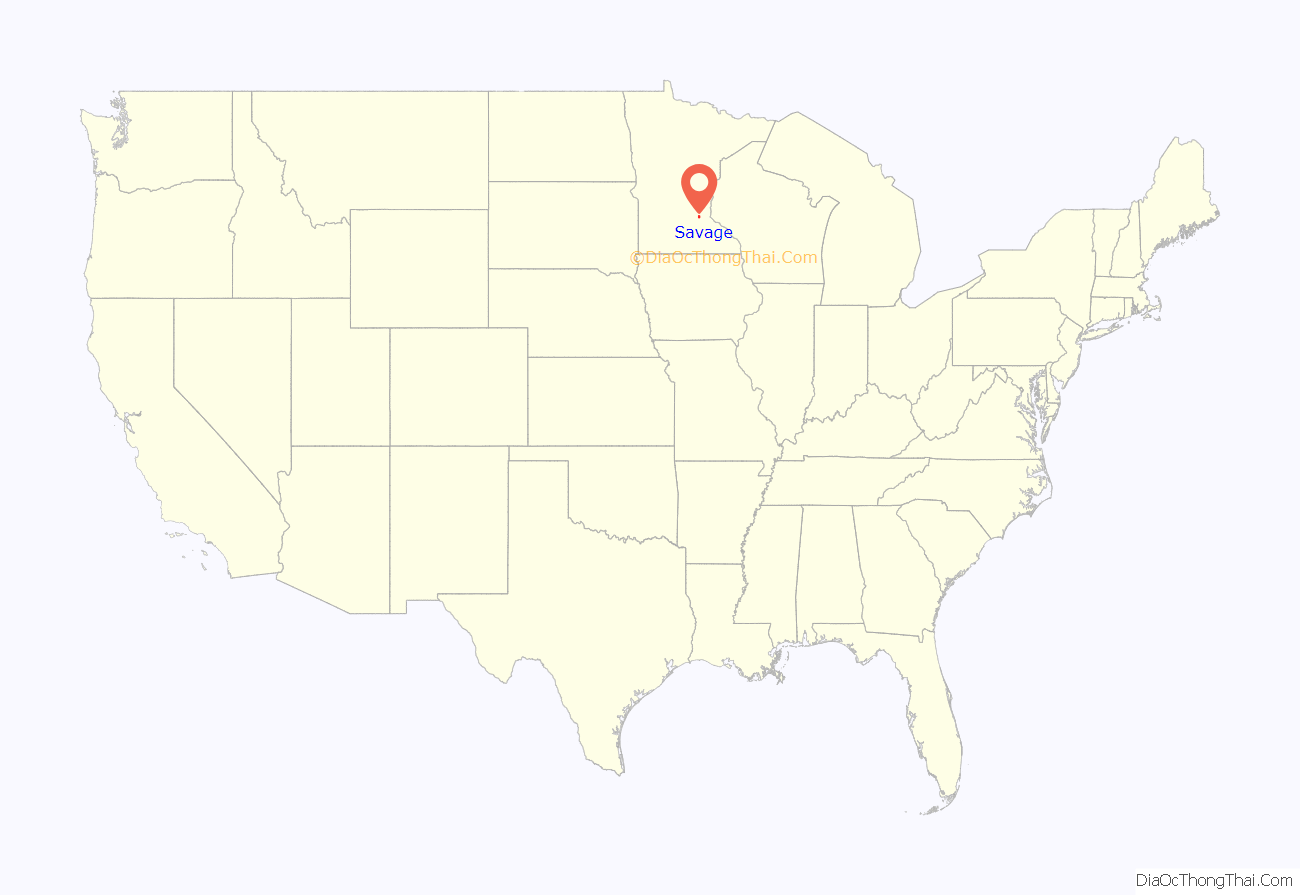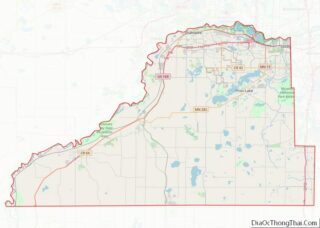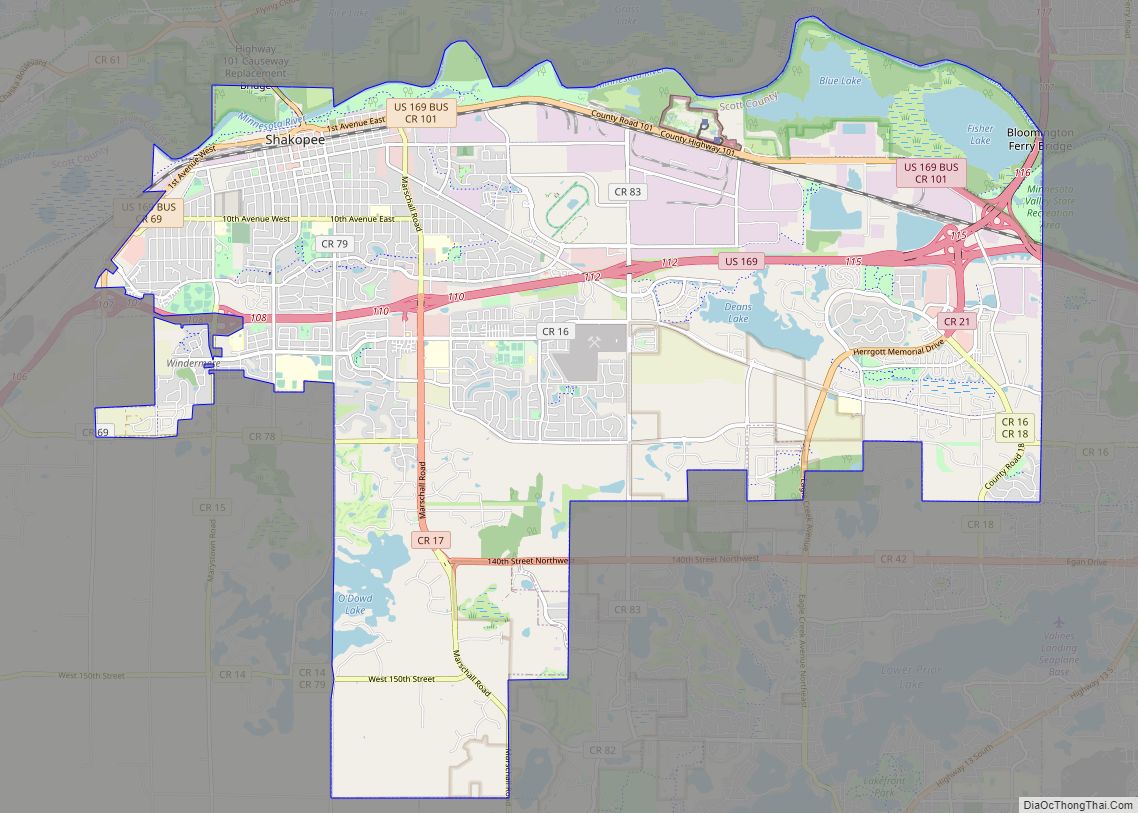Savage /ˈsævɪdʒ/ is a suburban city 15 miles (24 km) south-southwest of downtown Minneapolis in Scott County in the U.S. state of Minnesota. The city is on the south bank of the Minnesota River in a region commonly called South of the River, comprising the southern portion of Minneapolis-St. Paul, the 16th-largest metropolitan area in the United States. The population of Savage was 32,465 at the 2020 census.
Minnesota State Highway 13 and County Road 42 are two of the main routes in Savage. Interstate 35W and U.S. Highway 169 are in close proximity to the city.
The landing point for Irish and Scottish immigrants in 1800, Savage has grown into a developing bedroom community, absorbing population growth from Burnsville, its larger neighbor to the east. Once a shipbuilding port for the U.S. Navy, Savage is now an industrial manufacturing job center in the southern metro. The city is still relatively undeveloped, with sections of the Minnesota Valley National Wildlife Refuge and Murphy-Hanrehan Park Reserve within its borders.
Previously named Hamilton after the city in Ontario, Canada, the town was renamed Savage after Marion Willis Savage, who owned and trained the nationally celebrated racing horse Dan Patch.
| Name: | Savage city |
|---|---|
| LSAD Code: | 25 |
| LSAD Description: | city (suffix) |
| State: | Minnesota |
| County: | Scott County |
| Founded: | 1852 |
| Incorporated: | 1892 |
| Elevation: | 722 ft (220 m) |
| Land Area: | 15.60 sq mi (40.41 km²) |
| Water Area: | 0.82 sq mi (2.11 km²) 4.98% |
| Population Density: | 2,080.69/sq mi (803.35/km²) |
| ZIP code: | 55378 |
| Area code: | 952 |
| FIPS code: | 2758738 |
| GNISfeature ID: | 0651242 |
| Website: | cityofsavage.com |
Online Interactive Map
Click on ![]() to view map in "full screen" mode.
to view map in "full screen" mode.
Savage location map. Where is Savage city?
History
In the 17th century, French fur traders and explorers explored the Minnesota River valley. After 1750, Mdewakanton Dakota then settled at Chief Black Dog’s camp—near what is now Black Dog Lake in Burnsville. Dakota used the Minnesota River valley region including present-day Savage for fish, game, boating and camping.
In 1852, traders established a small post at the confluence of the Credit River and the Minnesota River. William Byrne, who immigrated from County Kilkenny, Ireland, to Hamilton, Ontario, Canada, in 1840, arrived in the area shortly after, via steamboat from Fort Snelling. Already established in business and trade, he and other Irish and Scottish settlers built Hamilton Landing, a port for boats, named after the city he immigrated to in Canada. The town incorporated in 1892 as the village of Hamilton. Byrne later settled another nearby area which became Burnsville.
The Chicago & North Western (present day Union Pacific Railroad) railway line reached the site in 1865, and in 1866 the town gained a post office. Hamilton became the crossroads of trade and service in the region with the Credit River, Minnesota River, the valley’s wagon and road trails, and the rail line.
The post office was later renamed Glendale Post Station in 1894 and formed Glendale Township to the west of Hamilton, but was later consolidated with Savage in 1969. The roughly 17 blocks of the late 19th-century town remain as Savage’s downtown along Highway 13 (Minnesota).
In 1902, Minneapolis entrepreneur Marion Willis Savage purchased racing horse Dan Patch and trained and raced him at his farm in the limits of Hamilton. Dan Patch’s notoriety grew as the horse began breaking speed records, and with it grew the town’s prestige. In 1904 the townspeople renamed the community after Savage with the post office officially confirming. In 1906 at the Minnesota State Fair, Dan Patch broke the world pacing mile record at 1 minute and 55 seconds, a record that remained unsurpassed for 54 years.
During World War II, Savage was home to Camp Savage, a Military Intelligence School (MIS) language program, which taught Japanese to American military personnel. Established in 1942, the school trained with niseis and improved military intelligence of the time. It was later relocated to Fort Snelling and is commemorated at Normandale College’s Japanese garden. At about the same time, Cargill, Incorporated, began building ships for the U.S. Navy at the newly constructed Meadowland Shipyard, renamed Port Cargill (former site of Hamilton Landing). To launch the ships, 14 miles (23 km) of the Minnesota River were dredged down to 9 feet (2.7 m) from Savage to the Mississippi River confluence. About 3,500 people were employed during peak production resulting in 18 auxiliary oil and gas carriers and 4 tugboats constructed. After World War II the port began shipping agricultural commodities.
Savage remained undeveloped in the postwar housing boom, isolated by the Minnesota River and without a direct interstate connection. Lack of available construction materials in the immediate area also prevented development. By the 1980s, with the upgrade of Highway 13 and construction of the Highway 169 Bloomington Ferry Bridge in 1996 across the Minnesota River, Savage finally boomed as one of the growing exurbs with low-cost greenfield land in the metropolitan area. The citizens of Savage reclaimed some of their history in the early 21st century, when it relocated the displaced Savage Depot built in 1880 by the then Chicago, Minneapolis and Omaha Rail Road.
Savage Road Map
Savage city Satellite Map
Geography
According to the United States Census Bureau, the city has an area of 16.45 square miles (42.61 km); 15.63 square miles (40.48 km) is land and 0.82 square miles (2.12 km) is water. The city’s northern boundary is the Minnesota River; its tributary the Credit River flows northward through the city.
See also
Map of Minnesota State and its subdivision:- Aitkin
- Anoka
- Becker
- Beltrami
- Benton
- Big Stone
- Blue Earth
- Brown
- Carlton
- Carver
- Cass
- Chippewa
- Chisago
- Clay
- Clearwater
- Cook
- Cottonwood
- Crow Wing
- Dakota
- Dodge
- Douglas
- Faribault
- Fillmore
- Freeborn
- Goodhue
- Grant
- Hennepin
- Houston
- Hubbard
- Isanti
- Itasca
- Jackson
- Kanabec
- Kandiyohi
- Kittson
- Koochiching
- Lac qui Parle
- Lake
- Lake of the Woods
- Lake Superior
- Le Sueur
- Lincoln
- Lyon
- Mahnomen
- Marshall
- Martin
- McLeod
- Meeker
- Mille Lacs
- Morrison
- Mower
- Murray
- Nicollet
- Nobles
- Norman
- Olmsted
- Otter Tail
- Pennington
- Pine
- Pipestone
- Polk
- Pope
- Ramsey
- Red Lake
- Redwood
- Renville
- Rice
- Rock
- Roseau
- Saint Louis
- Scott
- Sherburne
- Sibley
- Stearns
- Steele
- Stevens
- Swift
- Todd
- Traverse
- Wabasha
- Wadena
- Waseca
- Washington
- Watonwan
- Wilkin
- Winona
- Wright
- Yellow Medicine
- Alabama
- Alaska
- Arizona
- Arkansas
- California
- Colorado
- Connecticut
- Delaware
- District of Columbia
- Florida
- Georgia
- Hawaii
- Idaho
- Illinois
- Indiana
- Iowa
- Kansas
- Kentucky
- Louisiana
- Maine
- Maryland
- Massachusetts
- Michigan
- Minnesota
- Mississippi
- Missouri
- Montana
- Nebraska
- Nevada
- New Hampshire
- New Jersey
- New Mexico
- New York
- North Carolina
- North Dakota
- Ohio
- Oklahoma
- Oregon
- Pennsylvania
- Rhode Island
- South Carolina
- South Dakota
- Tennessee
- Texas
- Utah
- Vermont
- Virginia
- Washington
- West Virginia
- Wisconsin
- Wyoming











